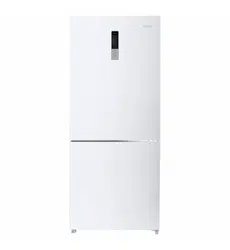Documents: Go to download!
User Manual
- User Manual - (English)
- Specifications Sheet - (English)
- PART NAMES AND LOCATIONS
- INSTALLATION INSTRUCTIONS
- ENERGY SAVING TIPS
- OPERATING INSTRUCTIONS
- GENERAL CARE AND MAINTENANCE
- TROUBLESHOOTING GUIDE
Table of contents
User Manual Refrigerator
PART NAMES AND LOCATIONS
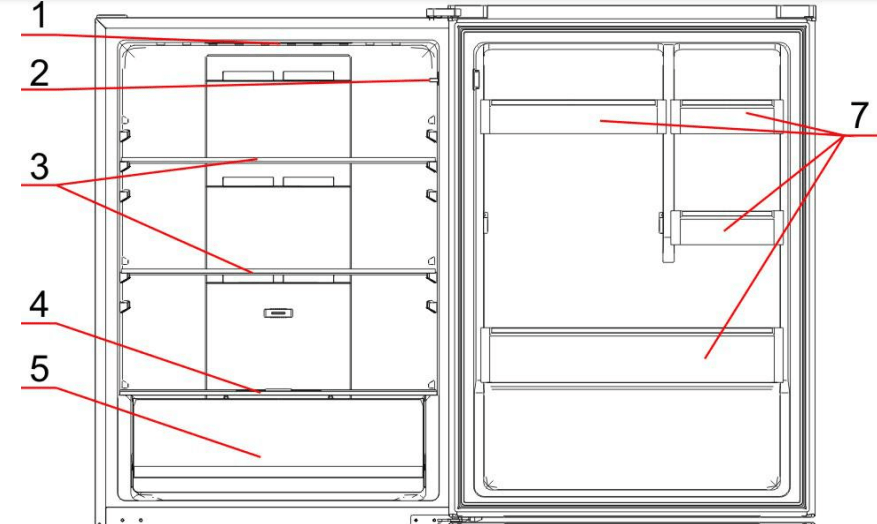
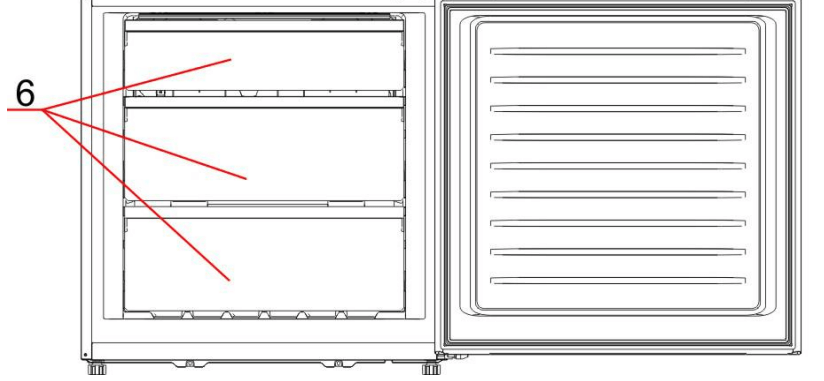
No | Description |
1 | Light |
2 | Lighting switch |
3 | Cooling room shelves |
4 | Vegetable and fruit crisper cover |
5 | Vegetable and fruit crisper |
6 | Freezing drawers |
7 | Door balcony |
INSTALLATION INSTRUCTIONS
Before Using the Refrigerator
- Remove the exterior and interior packing.
- Before connecting the refrigerator to a power source, let the unit stand upright for approximately 4 hours to mitigate the possibility of a malfunction in the cooling system from improper handling during transportation.
- Clean the interior surface with lukewarm water using a soft cloth. (Refer to the cleaning instruction on page 5)
Installing the Refrigerator
- This appliance is designed to be free-standing only, and should not be recessed or built-in.
- Place the refrigerator on a leveled/even floor surface that is strong enough to support the weight of the refrigerator when it is fully loaded to prevent vibrations and allow water to properly drain. The front feet can be adjusted to level the appliance properly.
- The leveling feet should only be used in forward and backward motions and never side to side.
- Allow at least 5cm of space between the back and sides of the refrigerator to allow proper air ventilation. Adjust the two front feet to keep the refrigerator leveled or elevated.
- Situate the refrigerator away from direct sunlight and sources of direct heat (stove, heater, radiator, etc.). Direct sunlight may also affect the acrylic coating and heat sources may cause an increase in electrical consumption. The ambient temperature below50°For above85°Fwill hinders the performance of this appliance.
- This unit is not designed for outside installation.
- Avoid situating the refrigerator in moist OR pest infestation areas.
- Plug the refrigerator into dedicated, properly installed-grounded wall outlet. Do not under any circumstances cut or remove the third (ground) prong from the power cord. Any questions concerning power and/or grounding should be directed toward a certified electrician or an authorized service center.
- After plugging the appliance into a wall outlet, turn the unit on and allow the unit to cool down for 2~3 hours before placing food in the refrigerator or freezer compartment.
- Do not place items on the top of this appliance.
ENERGY SAVING TIPS
- Allow hot foods to cool to room temperature before placing in the refrigerator. Overloading the refrigerator forces the compressor to work harder. Foods that freeze too slowly may lose quality, or spoil.
- Do not adjust the temperatures to colder than necessary. Refer to page 4 for temperature instructions.
- Be sure to wrap foods properly, and wipe containers dry before placing them in the refrigerator. This cuts down on frost build-up inside the refrigerator.
- Organize and label food to reduce door openings and extended searches. Remove as many items as needed at one time, and close the door as soon as possible.
- Refrain from leaving the door/s open for a long time to conserve energy.
OPERATING INSTRUCTIONS
START
1. Clean the parts of the refrigerator with lukewarm water containing a littleneutral detergentand with clear water, and wipe them dry. Notes: Electric parts of the refrigerator can only be wiped by dry cloth.
2.Turn on electricity. The compressor begins to work.
3.Open the door 30 minutes later, if the temperature in the refrigerator decreased obviously, it shows that the refrigerator system works well. When the refrigerator operates for a period of time, the temperature controller will automatically set the temperature within limits it opens.
The display is located in the middle of the refrigerator door. Please refer to the below figure for the layout.
Introduction of the button
(1) Fridge: to set the refrigerator temperature
(2) Freezer: to set the freezer temperature
(3) Function: to choose functions of fast cooling, fast freezing, intelligence and vacation
(4) OK: to enter or to quit the existing function
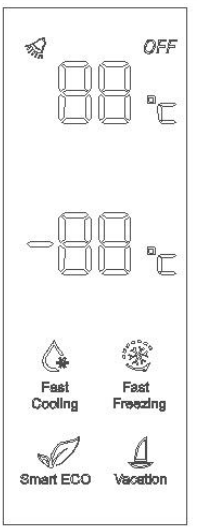
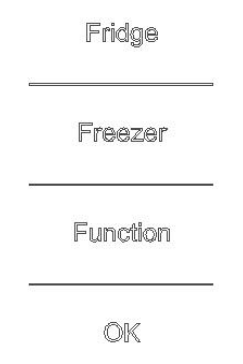
Function setting
★ appliance connected to power at the first time
When the appliance is connected to power at the first time, the display will be lit for 2 seconds before going normal and the appliance runs with intelligence function.
★display control
When the refrigerator door is closed and there is no button operation in 3 minutes, the display light goes off. When the display light is off, open the refrigerator door or click any button to light it up.
★temperature setting
1) Click the “refrigerator” or “freezer” button and when it flickers in the symbol, temperatures can be set; each time when the button is clicked, the temperature changes accordingly(the display shows the temperature accordingly). (Temperatures cannot be set under functions of fast cooling, fast freezing, intelligence and vacation,)
2) Under temperature setting, if there is no button operation in 5 seconds, the button stops flickering and the set temperature comes into effect.
3) Temperature cycle Refrigerator: 2℃→3℃→4℃→5℃→6℃→7℃→8℃→OFF→2℃;Freezer: -24℃→-23℃→-22℃→-21℃→-20℃→-19℃→-18℃→-17℃→-16℃→-24℃;
★intelligence
Under intelligence, it is 4℃ in the refrigerator and -18℃ in the freezer. Temperatures cannot be changed and you can click the temperature zone button to check the temperature.
1) To enter intelligence Click “option” until it flickers and then click “OK” to enter this function.
2) To quit intelligence Under intelligence, click “option” until it goes to intelligence, click “OK” to quit this function and the light goes off.
The temperatures of each chamber go back to the value before intelligence function.
★fast cooling
Under fast cooling, it is 2℃ in the refrigerator and the refrigerator temperature cannot be changed.
1)To enter fast cooling Click “option” until it flickers in “fast cooling” and then click “OK” to enter this function.
2) To quit fast cooling
Under fast cooling, click “option” until it goes to “fast cooling” and then click “OK” to quit this function.
The light in fast cooling goes off and the refrigerator temperature goes back to the value before fast cooling.
★fast freezing
Under fast freezing, refrigerator temperature can be set but not for the freezer temperature.
1) To enter fast freezing Click “option” until it flickers in “fast freezing” and then click “OK” to enter this function.
2) To quit fast cooling Under fast freezing, click “option” until it goes to “fast freezing” and then click “OK” to quit this function. The light in fast freezing goes off and the freezer temperature goes back to the value before fast freezing. When fast freezing time is up (26 hours), it quits automatically. When it goes to intelligence, fast freezing stops.
★vacation
Under vacation, it is 14℃ in the refrigerator and the temperatures in this chamber cannot be changed.
1) To enter vacation Click “option” until it flickers in “fast freezing” and then click “OK” to enter this function.
2) To quite vacation Under vacation, click “option” until it goes to “vacation” and then click “OK” to quit this function.The light in vacation goes off and the refrigerator temperature goes back to the value before vacation. Vacation quits under functions of intelligence and fast cooling.
★power off memory
With this design, the refrigerator can automatically keep all the settings in case of powers off. When the unit is plugged in again, the refrigerator will run with the setting before powering off.
★Power-On Delay
To prevent harm to the refrigerator in case of a sudden power cut and power on, the unit doesn't start immediately if the power off time is less than 5 minutes.
★Freezer over-temperature alarm (only in case of power on)
When the freezer temperature is higher than 10℃at the first time connected to power, the symbol light of the freezer chamber goes on and the number representing temperature flickers.Press any button or wait for 5 seconds, flickering stops and it goes back to the temperature that was set.
★Refrigerator door opening alarm
When the refrigerator is open over 3 minutes, the buzzer will buzz. Close the door or press any button to stop the alarm, but for the latter, the alarm will go off again after 3 minutes.
★Sensor fault alarm
When it shows “E0”, “E1”, “E2” or other abnormal symbols, it means sensor faults and the refrigerator needs repair.
IN USE
- The appliance might not operate consistently (possibility of defrosting of contents or temperature becoming too warm in the frozen food compartment) when sited for an extended period of time below the cold end of the range of temperatures for which the refrigerating appliance is designed
- The information about the climate range of the appliance is provided on the rated plate.
- The fact that the internal temperatures could be affected by such factors as the location of the refrigerating appliance, ambient temperature and the frequency of door opening, and, if appropriate, a warning that the setting of any temperature control device might have to be varied to allow for these factors
- The fact that effervescent drinks should not be stored in food freezer compartments or cabinets or in low-temperature compartments or cabinets, and that some products such as water ice should not be consumed too cold
- The need to not exceed the storage time(s) recommended by the food manufacturers for any kind of food。
Storage of food
- The cook dishes can be put into refrigerator to keep fresh after their temperature decreases to room temperature.
- Egg pockets and bottle pockets for eggs, butter, milk and bottle drinks, etc. Storage of food or containers should be left between the gap, so as not to affect the air- conditioning cycle
- The arrangement of food for storage, in particular, the need to avoid cross-contamination, such as food to be stored should be wrapped with clean plastic film or fresh-keeping paper, then distributed to several frames even to avoid contamination and the loss of water and smelling mixture.
- Fruits and vegetables should be put into the salad crisper to prevent excessive evaporation of water and freshness.
- Cool hot food down to the room temperature before storing otherwise consumption of electricity will increase and would lead to frost forming inside.
- In the case of refrigerating appliances with chill compartments, a statement to effect that some types of fresh vegetables and fruits are sensitive to cold, and that therefore they are not suitable for storage in this kind of compartment.
- The fact that effervescent drinks should not be stored in food freezer compartments or cabinets or in low-temperature compartments or cabinets, and that some products such as water ices should not be consumed too cold。
Tips for keeping food perfect in the Fridge
- Cooked meats should always be stored on a shelf above raw meats to avoid a bacterial transfer. Keep raw meats on a plate that is large enough to collect juices and cover it with cling film or foil.
- This allows cold air to circulate around the Fridge, ensuring all parts of the Fridgearekept cool.
- To prevent transfer of flavors and drying out, food should be separately packed or covered. Fruit and vegetables need not be wrapped.
- Allow pre-cooked food to cool down before placing in the Fridge. This will help to stop the internal temperature of the Fridge from rising.
- To prevent cold air from escaping, try to limit the number of times you open the door. When returning from shopping, sort foods to be kept in your Fridge before opening the door. 8 Only open the door to put food in or take it out.
Interruption of power supply or failure of the refrigerating system
- The care required with regard to frozen food in storage in the event of an extendednonrunning of the refrigerating appliance (interruption of power supply or failure of the refrigerating system)
- Do not open the refrigerator door as much as possible so that even in hot summer food can be safely and freshly kept for hours.
- If you have a power outage notice in advance:
- Please an hour in advance will be temperature control stalls transferred to a strong cold position, so that the refrigerator is fully frozen. (Note that this time do not store new food!)To be restored after the timely supply of temperature control gear to the original location.
- You can also make some ice, with a watertight container, and put it in the upper part of the freezer. So it is necessary to extend the time for fresh food to be deposited.
Preparations for freezing
- Leave cooked food to cool completely.
- Chill food in a Fridge before freezing if possible.
- Consider how you want to cook the food before freezing it. - Don’t freeze food in metal containers as you may want to microwave it straight from the freezer.
- Use special Freezer bags available from supermarkets, Freezer film, polythene bags, plastic containers, and aluminum foil for acidic foods(such as citrus fruits). Do not use thin cling film or glass. Do not use used food containers (unless cleaned thoroughly first).
- Exclude as much air from the container as possible. You could buy a special vacuum pump that sucks excessive air out of the packaging. - Leave a small amount of “air space” when freezing liquids, to allow for expansion.
- You can use the space in the Freezer most efficiently if you freeze liquids(or solids with liquids, such as stew) in square blocks. This is known as “performing” Pour the liquid into a polythene bag which is inside a square-sided container. Freeze it like this, then remove it from the container and seal the bag.
Tips for shopping for frozen foods
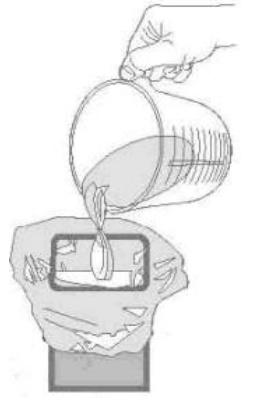
- When you are buying frozen food, look at the Storage Guidelines on the packaging. You will be able to store each item of frozen food for the period shown against the star rating. This is usually the period stated as “Best, Before”, found on the front of the packaging.
- Check the temperature of the frozen food cabinet in the shop where you buy your frozen foods.
- Make sure the frozen food package is in perfect condition.
- Always buy frozen products last on your shopping trip or visit to the supermarket.
- Try to keep frozen food together whilst shopping, and on the journey home as this will help to keep the food cooler.
- Don’t buy frozen food unless you can freeze it straight away. Special insulated bags can be bought from most supermarkets and hardware shops. These keep frozen food cold for longer. 9
- For some foods, thawing before cooking is unnecessary. Vegetables and pasta can be added directly to boiling water or steam cooked. Frozen sauces and soups can be put into a saucepan and heated gently until thawed.
- Use quality food and handle it as little as possible. Freeze food in small quantities, it freezes faster, takes less time to thaw and enables you to eat it in the quantity you need.
- First, estimate the amount of food you will be freezing. If you are freezing large amounts of fresh food, remember to turn the control dial to the low-temperature range. This will lower the temperature in the Freezer, freezing your food quicker and helping to keep the goodness in. However, you should do this sparingly to conserve energy.
Defrosting
- This appliance is designed as automatic defrosting ,no need to defrost by hand.
Notes
- If the unit is unplugged or loses power, please wait approximately 3 to 5 minutes before starting the unit. If there is any attempt to restart before this time delay, the refrigerator will not commence operation.
- Large quantities of food stored in the appliance or directly in front of the air vent will hinder the cooling efficiency of the appliance as this can affect the airflow.
- If you choose to change the thermostat settings in the fridge compartment, adjust the thermostat control by one increment at a time.
- Allow 24 hours for the temperature to stabilize between adjustments. Do not keep opening and closing the door once increasing the temperature.
GENERAL CARE AND MAINTENANCE
Cleaning the Refrigerator
- Upon installation of your new appliance, it is recommended that it be cleaned thoroughly and properly maintained thereafter.
- Turn off the refrigerator and then unplug the unit from the wall outlet.
- Remove all food content before washing the inside with a damp cloth soaked in lukewarm water and baking soda solution. The solution should be about 2 tablespoons of baking soda to a liter of water.
- Be sure to keep the door gasket (seal) clean to keep the unit running efficiently as improper cleaning can cause the seal to dislodge and tear.
- The exterior of the refrigerator should be cleaned with mild detergent and warm water. (door and side of the units only.
- Dry the interior and exterior with a soft cloth.
- The condenser coils should be vacuumed when they are dusty or dirty. The condenser is an internal tube, non-serviceable.
- Don’t need to remove the water tray above the compressor to empty water that will be evaporated by heat from the compressor.
Vacation Time
- Turn off the refrigerator first and then unplug the unit from the wall outlet.
- Remove all food.
- Clean the refrigerator.
- Leave the lid open slightly to avoid possible formation of condensation, mold, or odors.
- Use extreme caution in the case of children. The unit should not be accessible to child splay.
- Short vacations: Leave the refrigerator operating during vacations of less than three weeks.
- Long vacations: If the appliance will not be used for several months, remove all food and plug the power cord. Clean and dry the interior thoroughly. To prevent odor and mold growth, leave the door open slightly: blocking it open if necessary or have the door removed.
Repositioning and Relocating the Refrigerator
- Turn off the refrigerator first and then unplug the unit from the wall outlet.
- Remove all the food and drinks.
- Securely tape down all loose items inside your refrigerator.
- Tape the doors shut.
- Be sure the refrigerator stays in the upright position during transportation.
Save energy
- Install the refrigerator in the coolest part of the room, out of direct sunlight and away from heating ducts or registers. Do not place the refrigerator next to heat-producing appliances such as a range, oven or dishwasher.
- The refrigerator door should remain open only as long as necessary; do not place hot food inside the refrigerator.
- Organize the refrigerator to reduce door openings . Remove as many items as needed at one time and close the door as soon as possible.
- The refrigerator door should be properly closed to avoid increased energy consumption, and the formation of excess ice and/or condensation inside.
- Constantly circulating cold air keeps the temperature homogenous inside the refrigerator. For this reason, it is important to properly distribute the food, to facilitate the flow of air.
- Cover foods and wipe containers dry before placing them in the refrigerator. This cuts down on moisture build-up inside the unit.
- Do not overcrowd the refrigerator or block cold air vents. Doing so causes the refrigerator to run longer and use more energy. Shelves should not be lined with aluminum foil, wax paper or paper toweling. Liners interfere with cold air circulation, making the refrigerator less efficient, which could cause food spoilage.
- The arrangement of food for storage and for freezing, where applicable, particularly including advice that food to be frozen is not to be placed in direct contact with food storage and, if appropriate, that it could be necessary to reduce the quantity to be frozen if freezing every day is anticipated.
- During prolonged absences (for example: vacations), it is advisable to disconnect the refrigerator, remove all the food, and clean it . The door should be left slightly open to avoid mold and unpleasant odors. This will not affect the refrigerator when it is connected.
- During short absences (for example: holidays), the refrigerator can remain on. However, remember that prolonged power outages may occur while you are gone.
- The door to the evaporator clearance can be used to store food.
- The storage time(s) recommended by the food manufacturers for any kind of food and particularly for commercially quick-frozen food in food freezer and frozen-food storage compartments or cabinets.
- The precautions necessary to prevent an undue rise in the temperature of the frozen food while defrosting the refrigerating appliance, such as wrapping the frozen food in several layers of newspaper.
- The fact that a rise in temperature of the frozen food during manual defrosting, maintenance or cleaning could shorten the storage life.
- The care required with regard to frozen food in storage in the event of an extended non-running of the refrigerating appliance (interruption of power supply or failure of the refrigerating system).
- It is better to wrap the frozen food in several layers of glass shelves.
- The care required with regard to frozen food in stora.
TROUBLESHOOTING GUIDE
PROBLEM | POSSIBLE CAUSES |
| Refrigerator does not operate. |
|
| The light is not working. |
|
| Compressor runs all the time |
|
| Temperature inside the refrigerator is too warm |
|
| Temperature inside the refrigerator is too cold. |
|
| Temperature of external refrigerator surface is warm. |
|
| Popping or cracking sound when compressor comes on. |
|
| Bubbling or gurgling sound, like water boiling. |
|
| Vibrations. |
|
| Moisture forms on inside refrigerator walls. |
|
| Moisture forms on outside of refrigerator. |
|
| The doors will not close properly. |
|
See other models: L40H5 L32H5 U65H7 L40H4 L32H4
